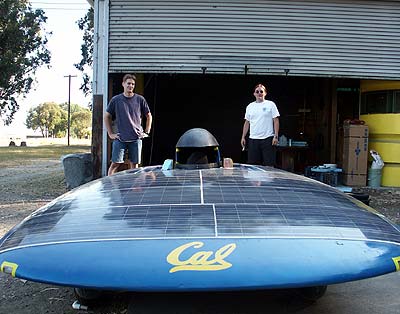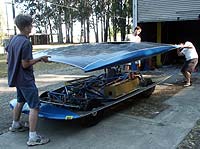 |
CalSol Captain Nathan Mandernack and team member John Connors show off Solar Bear at her Richmond Field Station home before she hits the road. (BAP photos) |
UC Berkeley students rely on sunshine to get their kicks on Route 66
BERKELEY - On Sunday, July 13, more than a dozen strange-looking vehicles pulled onto Route 66, the famous highway that winds from Chicago to Los Angeles. Rolling along like UFOs on wheels or land-bound flounders, most of these machines cost more than any Porsche they might pass on the way. Furthermore, they won't be stopping for gas even once in their 10-day, 2,300-mile, eight-state journey - they're solar.
"Get Your Kicks On Route 66" Well it winds from Chicago to L.A.
Well it goes from St. Louie down Would you get hip to this kindly tip (written by Bobby Troup) |
Sitting about two feet off the ground, CalSol's Solar Bear was built for aerodynamic and fuel efficiency, not for comfort. Although race regulations specify that drivers must weigh at least 75 kilos (165 pounds) or make up the difference with lead shot, it's obvious that only the most svelte members of CalSol could strap on the motorcycle helmet and shimmy their hips into the cockpit.
"It was basically whoever could cram themselves in there," admits CalSol team captain Nathan Mandernack, a senior mechanical engineering (ME) and materials science double major at UC Berkeley.
Says Yukfai Tham, ME graduate student and one of the car's two drivers, "It's fun to drive, but not that comfy." That's an understatement. Jason Huey, the other driver (who graduated in May with a degree in ME), says twin bruises lingered on his back after the May qualifying races held in Kansas, in which the solar cars had to do 67 laps (140 miles) in one day. Afterward, Tham added a ragged 1-inch-thick piece of foam to the car's carbon-fiber floor to serve as a seat for the grueling Route 66 race.
Stretched out over 10 days, the American Solar Challenge race is broken up into nine checkpoints, five of them mentioned in the famous "Route 66" song. The rules are simple: whichever team makes it to the finish line in the shortest total elapsed time with the fewest penalty points wins. If a car runs out of power because it's cloudy or it's used up too much energy climbing hills, it can be transported to the next segment by trailer - but that incurs penalty points. The race is sponsored by the U.S. Department of Energy (DOE), DOE's National Renewable Energy Laboratory, BP Solar and EDS to promote general awareness of solar energy.
Driving with the red team
The Solar Bear, CalSol's fourth solar car, is finally hitting the road after some four years in development. The UC Berkeley student group's first vehicle, the California Dreamin', was begun in 1990 and competed in Sunrayce '93, a race from Texas to Minnesota, and other solar car competitions. In 1996 CalSol decided to maximize its resources and joined forces with a controversial ally: Stanford. In 1997's nine-day Sunrayce, the combined Team California took third place with its entry Afterburner II. The unlikely partnership continued through another car, the Third Degree Burner, and another Sunrayce in 1999.
Then both teams decided that they were ready to go their separate ways. "We were tired of driving down to Palo Alto," says Mandernack.
Solar Bear shined at this year's Formula One Grand Prix in May, the qualifying track race for the American Solar Challenge. It took first in its class ("stock class, where you don't spend as much money as in the open class, but you make something really robust," explains Mandernack). That doesn't mean the car was ready for Route 66. The CalSol team realized that before they put the car on the highway, they needed to improve the aerodynamics, add wheel fairings to streamline the suspension, and integrate telemetry, the system that transmits Solar Bear's vital signs to a chase car.
 |
|
| Solar Bear's shell is made from a carbon-fiber composite that the team cast themselves. | |
 |
|
| Driver Yukfai Tham shows where he plans to spend half of the 2,300 mile race (another driver, Jason Huey, will share the duty), only wearing a motorcycle helmet and covered by the car's shell. Drivers steer using the yellow cables. | |
 |
|
| The left button turns the car on, the right switch throws it in reverse. |
The car itself has no instrumentation, not even a speedometer, and only a rudimentary cable steering system: the driver pulls on the left cable to turn left. But thanks to the telemetry and the support cars, the driver makes very few decisions anyway. In addition to the chase car, the CalSol team drives a lead car that effectively boxes in the Solar Bear, protecting the vehicle from highway traffic. "It's scary, because everyone in these SUVs is looking at our car and not at the road," admits Huey. And even though to maximize its energy usage the Solar Bear will probably average just 25 miles per hour during the race, "it still feels really fast, because the car's so low to the ground, and everything's shaking and you have the wind in your face." The car can reach speeds up to 75 mph, but not while conserving its precious charge of sunlight.
Solar Ferraris
Even in their sunniest dreams, CalSol is not expecting Solar Bear to win the race. The $80,000 they spent building the car - using donations from the College of Engineering Dean's Office and a few private sponsors like Powerlight, a Berkeley solar technology company - is a pittance compared to most other teams. CalSol is a stock-class entry, where costs are restricted. Those competing in the open class have no limitations on their budgets, or what type of batteries and solar arrays they can use. Open-class university teams must have friends with very deep pockets: some American Solar Challenge cars have cost as much as $1 million to design and fabricate.
The CalSol team claims not to mind the disparity in resources, or the fact that some teams have 30 members to CalSol's 10 and haul their cars across country in custom buses with designer logos. The Berkeley team rents a truck from Ryder to tow a homemade trailer. "It seems almost obscene to spend $200,000 just on a solar array for a car when we can build three Solar Bears for that," shrugs Mandernack. And although CalSol did spring for a $17,000 high-efficiency motor that's specially made for solar cars, they're not using Bridgestone's solar-car tires, which cost $90 apiece and are so temperamental that 20 to 30 would be required to make it through the race. Instead, they're using a more rugged $10 moped tire.
Solar Bear holds eight 12-volt batteries, which when fully charged can keep the car running most of the day at 35 mph even when it's cloudy. It uses a regenerative braking system, meaning when the driver pushes on the brakes just a little, the motor recharges the batteries and slows the car; if he slams down on the brake pedal, disc brakes take over. The shell is made from a lightweight but sturdy carbon-fiber composite that the team members cast themselves using giant molds. "It's pretty tough, and would be pretty safe in a crash," says Mandernack. "We have to do impact analyses to qualify for the race."
For the CalSol team, just getting the car on the highway represents a satisfying conclusion to four years of hard work. Some have been putting in as much as 30 hours a week this summer, on top of full-time jobs, to get the car race-worthy. They do it not to save the world through solar power, but because they are - forgive the stereotype - male engineers. Team member John Connors, a fourth-year computer science and math double major, sums up the motivation best: "I like cars, and I like to work with my hands."
While other alternative cars, such as the Supermileage and the Human Powered vehicles, are also being built and raced by Berkeley student teams, the 10-day solar car competition has a unique appeal. It takes place on the open road. "Other vehicle teams just race around a track a few times," sniffs Mandernack. "We put more miles on our car just during the qualifier than other kinds of cars will ever have in their lives. And now we're about to race 2,300 miles in something we built ourselves from the ground up, which is pretty cool."
And they're off – sort of! The race began Sunday, July 13, but CalSol and entries from two other universities suffered last-minute mechanical problems that kept them from departing on time. According to American Solar Challenge, all three cars eventually made it out of the starting gate in Chicago, but at last report CalSol was quite a few miles behind in the race. Daily updates and rankings are posted on the American Solar Challenge website.

